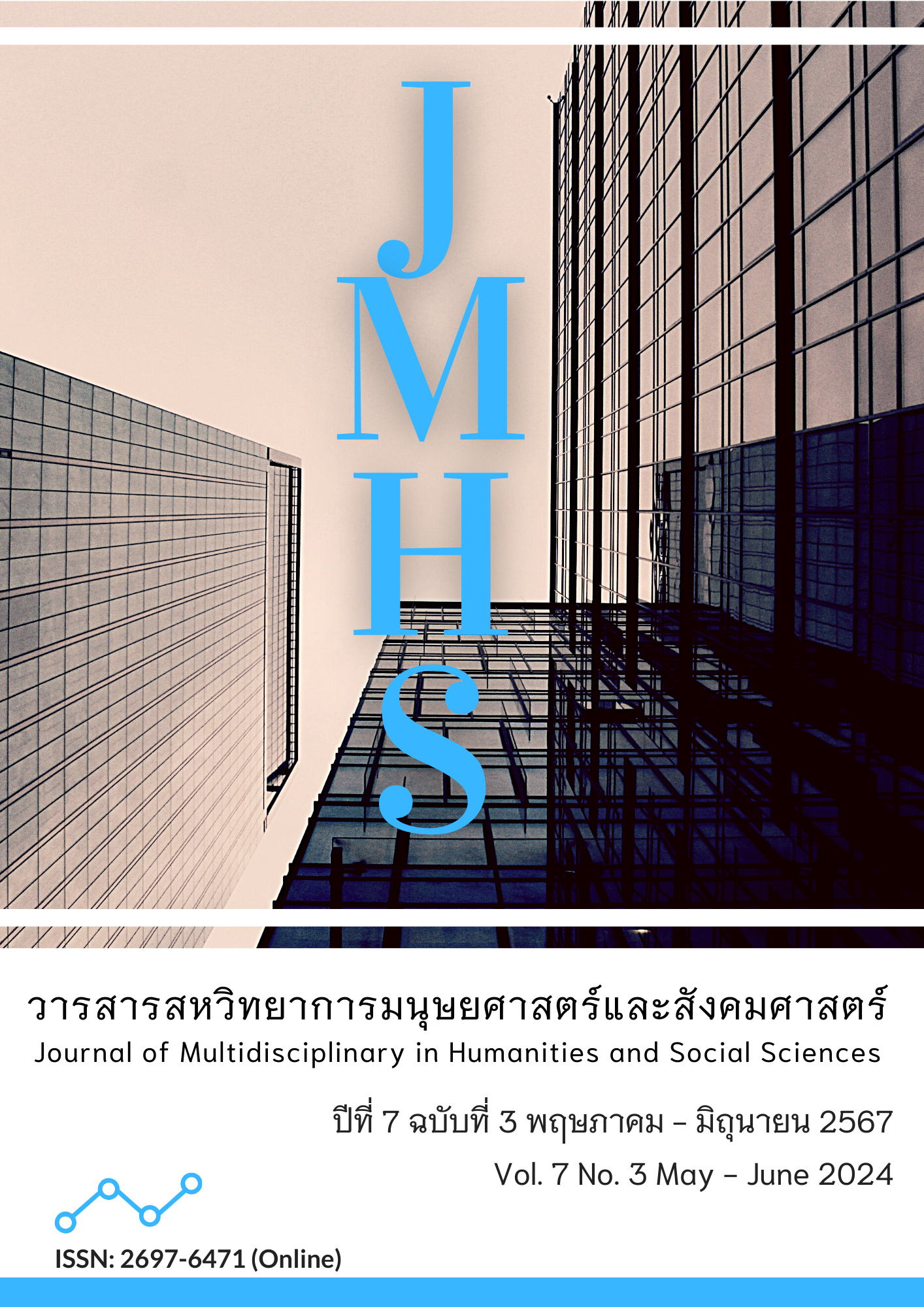The Premprachakorn Canalside Community Health Management Model for Driving Thailand’s Sustainable Development Goals: A Premprachakorn Canalside Community Development Project: Pracharuamjai 2 Community, Bangkok
Main Article Content
Abstract
The Premprachakorn Canalside Community Health Management Model for Driving Sustainable Development Goals aimed to: 1) study the components of the model; 2) develop and validate the model; and 3) recommend guidelines for model implementation. The mixed research design consisted of three phases: Phase 1 involves qualitative research from a document study and key informant opinions of 30 people, purposefully selected.; Phase 2 comprises quantitative research from a sample group of 200 people, using cluster random sampling; and Phase 3 involves qualitative research from the opinions of key informants of 11 people, purposefully selected. Tools utilized included: 1) textbooks, literature, and research; 2) semi-structured interview forms; and 3) questionnaires. Statistical analyses included frequency, percentage, mean, standard deviation, skewness, kurtosis, component analysis, the Partial Least Squares Structural Equation Model (PLS-SEM), and content analysis. The research findings revealed that:
1. Components of the Premprachakorn Canalside community health management model included factors determining community health, residents' attitudes and feelings, and management of health in the Premprachakorn Canalside community.
2. The results of model creation and validation meet all criteria for external and internal model evaluation using the PLS-SEM method and can explain the outcomes of the Premprachakorn Canalside community health management model by 71.8 percent.
3. The Premprachakorn Canalside community health management model was consistent with quantitative and qualitative analysis results and can be applied to enhance sustainable development goals in the future.
Article Details

This work is licensed under a Creative Commons Attribution-NonCommercial-NoDerivatives 4.0 International License.
Views and opinions appearing in the Journal it is the responsibility of the author of the article, and does not constitute the view and responsibility of the editorial team.
References
ไกรสร วันละ และ เสาวลักษณ์ โกศลกิตติอัมพร. (2564). การขับเคลื่อนเป้าหมายการพัฒนาอย่างยั่งยืนของประเทศไทย. วารสาร มจร บาฬีศึกษาพุทธโฆสปริทรรศน์, 7(3), 56-66. สืบค้นจาก https://so05.tci-thaijo.org/index.php/Palisueksabuddhaghosa/article/view/253638
ชยภรณ์ บุญเรืองศักดิ์ และ สุทธิพงษ์ เอี่ยมอ่อง. (2561). การจัดการสุขภาวะชุมชน เพื่อเสริมสร้างความเข้มแข็งให้กับชุมชนท้องถิ่น องค์การบริหารส่วนตำบลซับสมบูรณ์ จังหวัดเพชรบูรณ์. วารสารวิจัยเพื่อการพัฒนาเชิงพื้นที่, 10(1), 55-69. สืบค้นจาก https://so01.tci-thaijo.org/index.php/abcjournal/article/view/111973
ชิรวัฒน์ นิจเนตร. (2560). การวิจัยพัฒนารูปแบบทางสังคมศาสตร์และการศึกษา. วารสารราชภัฏสุราษฎร์ธานี, 4(2), 71-102. สืบค้นจาก https://so05.tci-thaijo.org/index.php/srj/article/view/123081
เทพพิทักษ์ นิลวรรณ์. (2562). การเปลี่ยนแปลงเชิงสัณฐานของชุมชนโอ่งอ่างและชุมชนสะพานหัน. สืบค้นเมื่อ 14 มกราคม 2565 จาก https://digital.car.chula.ac.th/chulaetd/9743/
บัญญัติ ยงย่วน และคณะ. (2559). การพัฒนาตัวชี้วัดสุขภาวะทางวัฒนธรรมระดับชุมชน. วารสารศิลปะศาสตร์ มหาวิทยาลัยสงขลานครินทร์ วิทยาเขตหาดใหญ่, 8(1), 113-133. สืบค้นจาก https://so03.tci-thaijo.org/index.php/journal-la/article/view/61861
ประคอง สุคนธจิตต์ และคณะ. (2564) บ้านมั่นคง: บ้านของคนชุมชนในเมือง. วารสารการบริหารและสังคมศาสตร์ปริทรรศน์, 4(2), 143-58. สืบค้นจาก https://so03.tci-thaijo.org/index.php/assr/article/view/253653
พระมหาไกรสร แสนวงศ์. (2562). รูปแบบการจัดการสุขภาวะชุมชนโดยใช้วัฒนธรรมชุมชนเป็นฐาน. วารสารการบริหารท้องถิ่น, 12(1), 55-72. สืบค้นจาก https://so04.tci-thaijo.org/index.php/colakkujournals/article/view/180427
เพ็ญ สุขมาก. (2561). หลักคิด: สุขภาพ สุขภาวะ ปัจจัยกำหนดสุขภาพ การสร้างเสริมสุขภาพ. การประชุมเชิงปฏิบัติการ การพัฒนาเครือข่ายนักติดตามประเมินผลงานสร้างเสริมสุขภาพ ในเขตพื้นที่ภาคเหนือ. วันที่ 19-21 ตุลาคม 2561 ณ ห้องประชุมพิกุล คณะมนุษยศาสตร์และสังคมศาสตร์ มหาวิทยาลัยราชภัฏกำแพงเพชร อ.เมือง จ.กำแพงเพชร. สืบค้นเมื่อ 14 มกราคม 2565 จาก https://mehealthpromotion.com/paper/126
มธุลีห์ โยคี และ ประพนธ์ สหพัฒนา. (2564). ความสำเร็จและความล้มเหลวของนโยบาย “โครงการพัฒนาที่อยู่อาศัยชุมชนริมคลอง”. วารสารชุมชนวิจัยราชภัฏนครราชสีมา, 15(4), 13-27. สืบค้นจาก https://so04.tci-thaijo.org/index.php/NRRU/article/view/247561
มนตรี พิริยะกุล. (2562). การใช้โปรแกรม Smart PLS สำหรับการวิจัยด้วยตัวแปรสมการโครงสร้าง. กรุงเทพฯ: สำนักงานวิจัยแห่งชาติ.
ยุทธ ไกยวรรณ์. (2556). การวิเคราะห์โมเดลสมการโครงสร้างด้วย AMOS. กรุงเทพฯ: สำนักพิมพ์แห่งจุฬาลงกรณ์มหาวิทยาลัย.
เริงวิชญ์ นิลโคตร และนพพร จันทรนำชู. (2561). การวิจัยปฏิบัติการแบบมีส่วนร่วมในการพัฒนาการเรียนรู้ชุมชนแนวปฏิบัติเพื่อสุขภาวะชุมชน. สักทอง: วารสารมนุษยศาสตร์และสังคมศาสตร์ (สทมส.), 24(1), 167-180. สืบค้นจาก https://so05.tci-thaijo.org/index.php/tgt/article/view/129859
วุฒิ สุขเจริญ. (2561). วิจัยการตลาด. กรุงเทพฯ: สำนักพิมพ์แห่งจุฬาลงกรณ์มหาวิทยาลัย.
วิชญ์วิสิฐ พรหมด, ธีราพร ทองปัญญา และ ชลิตา บัณฑุวงศ์. (2563). ผลกระทบจากโครงการพัฒนาที่อยู่อาศัยชุมชนริมคลอง กรณีศึกษา: ชุมชนริมคลองถนนฝั่งตะวันตก กรุงเทพมหานคร. วารสารรามคำแหง ฉบับมนุษยศาสตร์, 39(1), 73-88. สืบค้นจาก https://so05.tci-thaijo.org/index.php/huru/article/view/244699
ศุภินธน์การย์ ระวังวงศา. (2564). การจัดทำแผนยุทธศาสตร์การพัฒนาชุมชนริมคลองลาดพร้าวบนหลักการพันธกิจสัมพันธ์มหาวิทยาลัยกับสังคม. วารสารวิชาการ คณะมนุษยศาสตร์และสังคมศาสตร์ มหาวิทยาลัยราชภัฏพระนคร, 5(2), 67-108. สืบค้นจาก https://so06.tci-thaijo.org/index.php/husojournalpnru/article/view/253448
สถาบันพัฒนาองค์กรชุมชน. (2565). แผนปฏิบัติการ ปีงบประมาณ พ.ศ.2565. กรุงเทพฯ: สถาบันพัฒนาองค์กรชุมชน (องค์การมหาชน).
สมชัย แสนภูมิ. (2565). การวิจัยเอกสารเพื่อสังเคราะห์องค์ประกอบของชุมชนเข้มแข็งในประเทศไทย. วารสารรัฐศาสตร์ มหาวิทยาลัยมหามกุฏราชวิทยาลัย, 3(5), 48-64. สืบค้นจาก https://so02.tci-thaijo.org/index.php/jpsmbu/article/view/265583
สุภางค์ จันทวานิช. (2559). การวิเคราะห์ข้อมูลในการวิจัยเชิงคุณภาพ. (พิมพ์ครั้งที่ 12). กรุงเทพฯ: สำนักพิมพ์แห่งจุฬาลงกรณ์มหาวิทยาลัย.
สุรักษ์ ขุนทอง และ สินีนาถ ศุกลรัตนเมธี. (2563). ความสัมพันธ์ของการใช้พื้นที่เปิดโล่ง ริมคลองโอ่งอ่างกับชุมชนบริเวณโดยรอบ. วารสารวิชาการlถาปัตยกรรมศาสตร์, 70(1), 17-36. สืบค้นจาก https://so01.tci-thaijo.org/index.php/AJA/article/view/212784
สำนักงานบริหารนโยบายของนายกรัฐมนตรี (PMDU). (6 เมษายน 2564). ประเทศไทยกับการเดินหน้าสู่การพัฒนาที่ยั่งยืน. สื่อค้นเมื่อ 12 มกราคม 2565, จาก
https://www.pmdu.go.th/thailand-sustainable-development/
อรพรรณ คงมาลัย และ อัญณิฐา ดิษฐานนท์. (2561). เทคนิคการวิจัยด้านการบริหารเทคโนโลยีและนวัตกรรม. กรุงเทพฯ: สำนักพิมพ์มหาวิทยาลัยธรรมศาสตร์.
อนัญพร อิ่มจงใจรักษ์ (2562). ปัจจัยที่ส่งผลต่อความสำเร็จในการพัฒนาชุมชนต้นแบบพื้นที่สุขภาวะเขตภาษีเจริญ กรุงเทพมหานคร. สืบค้นเมื่อ 14 มกราคม 2565 จาก https://repository.nida.ac.th/handle/662723737/5082
อัครนันท์ อริยศรีพงษ์ และ กมลาศ ภูวชนาธิพงศ์. (2561). รูปแบบความสัมพันธ์เชิงสาเหตุปัจจัยด้านสภาพแวดล้อมและจิตวิทยาเชิงบวกที่มีต่อสุขภาวะองค์รวมแนวพุทธของครอบครัวในชุมชนอาคารสูง เขตกรุงเทพมหานคร. วารสารมหาจุฬานาครทรรศน์, 5(2), 233-249. สืบค้นจาก https://so03.tci-thaijo.org/index.php/JMND/article/view/140261
Dewi, L., Tentama, F., & Dahlan, A. M. (2021). Subjective Well-being: Mental health study among student in the Islamic boarding school. International Journal of Public Health Science (IJPHS), 10(1), 146-158. https://doi.org/10.11591/ijphs.v10i1.20610
Hair, J. F. (Jr.), Ringle, C. M., & Sarstedt, M. (2011). PLS-SEM: Indeed a Silver Bullet. Journal of Marketing Theory and Practice, 19(2), 139-151. https://doi.org/10.2753/MTP1069-6679190202
Hair, J. F. (Jr.), Hult, G. T. M., Ringle, C. M., & Sarstedt, M. (2014). A Primer on Partial Least Squares Structural Equation Modeling (PLS-SEM). California, CA: Sage Publications. Retrieved January 14, 2022 from https://www.ejtr.vumk.eu/index.php/about/article/download/134/133
Miller, G., & Foster, L. T. (2010). A brief summary of holistic wellness literature. Journal of holistic healthcare, 7(1), 4-8. Retrieved January 14, 2022 from https://bhma.org/wp-content/uploads/2017/07/JHH7.1_article1_.pdf
Neve, J-E. D., & Sachs, J. D. (2020). Sustainable Development and Human Well-Being. Manchester: The Wellbeing Research Centre at Oxford, 112-127.Retrieved January 14, 2022 from https://www.jstor.org/stable/pdf/resrep25851.9.pdf
Sumargo, B., & Novalia, T. (2018). Structural Equation Modelling for Determining Subjective Well-Being Factors of the Poor Children in Bad Environment. Procedia Computer Science, 135(2018), 113-119. https://doi.org/10.1016/j.procs.2018.08.156
TOV, William. (2018). Well-being concepts and Components in Handbook of subjective well-being. Salt Lake City: Noba Scholar, 1-15. Retrieved January 14, 2022 from https://ink.library.smu.edu.sg/soss_research/2836


